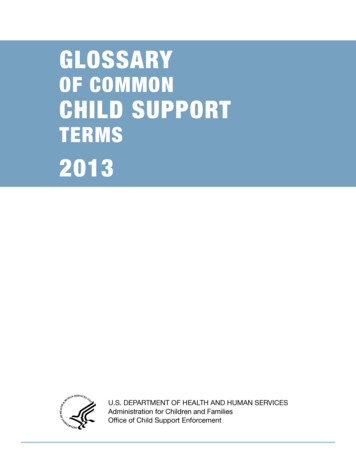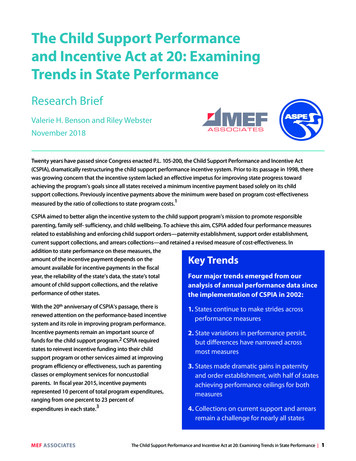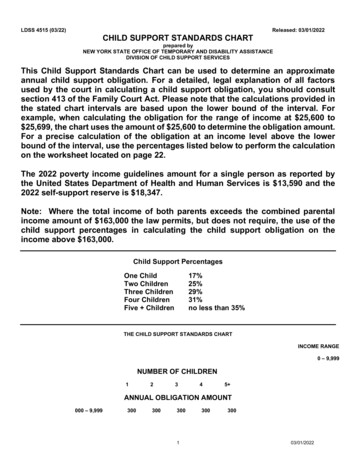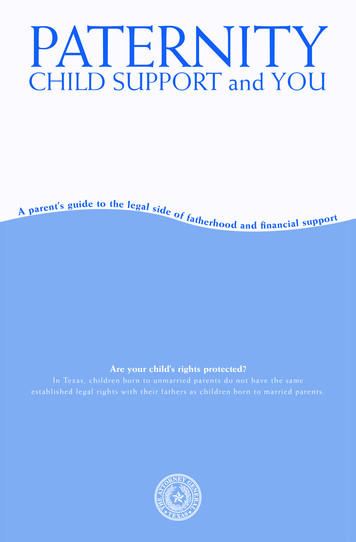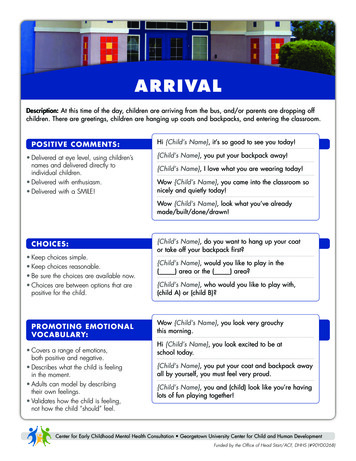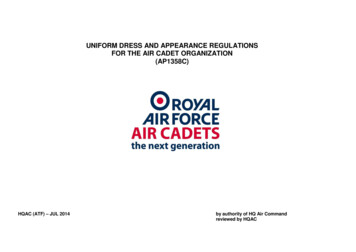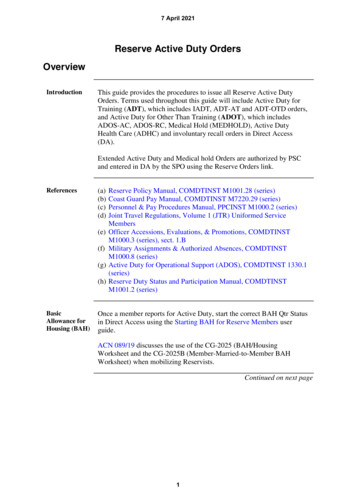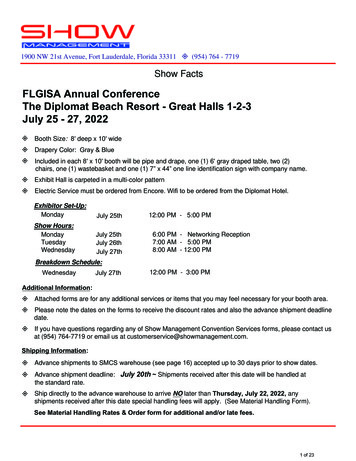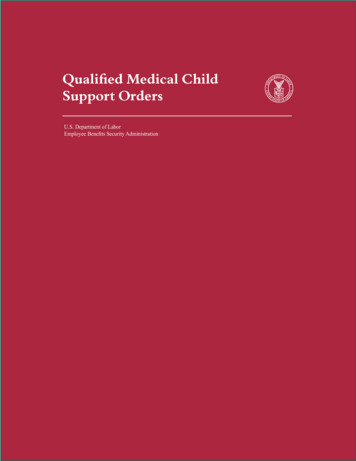
Transcription
Qualified Medical ChildSupport OrdersU.S. Department of LaborEmployee Benefits Security Administration
This publication has been developed by the U.S. Department ofLabor, Employee Benefits Security Administration.To view this and other EBSA publications, visit the agency’s website.To order publications or speak with a benefits advisor, contact EBSAelectronically.Or call toll free at: 1-866-444-3272This material will be made available in alternative format to personswith disabilities upon request:Voice phone: (202) 693-8664TTY:(202) 501-3911This booklet constitutes a small entity compliance guide for purposesof the Small Business Regulatory Enforcement Fairness Act of 1996.
Qualified Medical ChildSupport OrdersU.S. Department of LaborEmployee Benefits Security Administration
IntroductionA 1993 amendment to the Employee Retirement Income Security Act (ERISA) requiresemployment-based group health plans to extend health care coverage to the children of aparent-employee who is divorced, separated, or never married when ordered to do so bystate authorities. This compliance assistance guide explains these ERISA provisions anddescribes how a plan can be required to cover a child.Generally, a state court or agency may require an ERISA-covered health plan to providehealth benefits coverage to children by issuing a medical child support order. The grouphealth plan must determine whether the medical child support order is “qualified.” Suchan order is referred to as a Qualified Medical Child Support Order (QMCSO). In addition,a state child support enforcement agency may obtain group health coverage for a childby issuing a National Medical Support Notice that the group health plan determines to bequalified.Group health plan sponsors and administrators will find the information in this bookletuseful in understanding the rights and obligations of those involved in child supportproceedings and those responsible for administering group health plans.1The first section of this booklet provides general questions and answers about QualifiedMedical Child Support Orders. The second section answers questions about NationalMedical Support Notices and the role of state child support enforcement agencies inobtaining health care coverage on behalf of children. A final resource section lists additionalresources that may provide useful information about ERISA and obtaining health carecoverage and medical care for children.As used in this booklet, the term “group health plan” refers to that term as defined in section 607(1) of ERISA and meansgenerally any welfare plan established or maintained by an employer or employee organization (or both) that providesmedical care to employees or their dependents directly or through insurance, reimbursement, or otherwise.11
Section 1This section includes an overview of the ERISA provisions that require group healthplans to extend health care coverage to children of eligible participants and beneficiaries,plus general information about the requirements that apply to a Qualified Medical ChildSupport Order (QMCSO). Questions addressed in this section:q What is a QMCSO?q Who can be covered by a QMCSO?q What information is required for a medical child support order to be qualified?q Who determines whether a medical child support order is qualified?q What types of health plans are required to recognize QMCSOs?3
Q 1-1:What types of plans are subject to the QMCSO provisions?The QMCSO provisions apply to “group health plans” subject to theEmployee Retirement Income Security Act of 1974 (ERISA). For thispurpose, a “group health plan” generally is a plan that both:m Is sponsored by an employer or employee organization (or both) andprovides “medical care” to employees, former employees, or theirfamilies.m “Medical care” means amounts paid for the diagnosis, cure, mitigation,treatment or prevention of a disease; for the purpose of affectingany structure or function of the body; transportation primarily for oressential to such care or services; or for insurance covering such careor services.m ERISA does not generally apply to plans maintained by: Federal, stateor local governments; churches; and employers solely for purposes ofcomplying with applicable workers compensation or disability laws.However, provisions of the Child Support Performance and IncentiveAct (CSPIA) of 1998 require church plans to comply with QMCSOsand National Medical Support Notices, and state and local governmentplans to comply with National Medical Support Notices.[ERISA §§ 4(b), 609(a) and 607(1), Internal Revenue Code§ 213(d), CSPIA § 401(f)]Q 1-2:What is a QMCSO?A QMCSO is a medical child support order that:m Creates or recognizes the right of an alternate recipient to receivebenefits for which a participant or beneficiary is eligible under agroup health plan or assigns to an alternate recipient the right of a4
participant or beneficiary to receive benefits under a group healthplan; andm Is recognized by the group health plan as “qualified” because itincludes information and meets other requirements of the QMCSOprovisions (see Qs 1–6 and 1-7).In addition, a properly completed National Medical Support Notice(see Section 2) must be treated as a QMCSO.[ERISA § 609(a)(2), 609(a)(5)(C)]Q 1-3:What is a medical child support order?A medical child support order is a judgment, decree, or order(including an approval of a property settlement) that:m Is made pursuant to state domestic relations law (including acommunity property law) or certain other state laws relating tomedical child support (see Q1-8); andm Provides for child support or health benefit coverage for a childof a participant under a group health plan and relates to benefitsunder the plan.[ERISA § 609(a)(2), Social Security Act § 1908]Q 1-4:Must a medical child support order be issued by a statecourt?No. Any judgment, decree, or order that is issued by a court ofcompetent jurisdiction or an administrative agency authorized toissue child support orders under state law (such as a state childsupport enforcement agency) that provides for medical support of achild is a medical child support order.[ERISA § 609(a)(2)]5
Q 1-5:Who can be an alternate recipient?Any child of a participant in a group health plan who is recognizedunder a medical child support order as having a right to enrollmentunder the plan with respect to such participant is an alternaterecipient.[ERISA § 609(a)(2)]Q 1-6:What information must a medical child support ordercontain to be a “qualified” order?A medical child support order must contain the followinginformation in order to be qualified:m The name and last known mailing address of the participant andeach alternate recipient. The order may substitute the name andmailing address of a state or local official for the mailing addressof any alternate recipient;m A reasonable description of the type of health coverage to beprovided to each alternate recipient (or the manner in which suchcoverage is to be determined) ; andm The period to which the order applies.[ERISA § 609(a)(3)]Q 1-7:What other requirements must a medical child supportorder meet to be a “qualified” order?An order may not require a plan to provide any type or form ofbenefit, or any option, not otherwise provided under the plan, exceptto the extent necessary to meet the requirements of certain state lawsdescribed in Q1-8 below.[ERISA § 609(a)(4)]6
Q 1-8:What state laws relating to medical child support can beenforced by a QMCSO?At the time that the QMCSO provisions were added to ERISA,Congress also added section 1908 to the Social Security Act. Section1908 says that states cannot receive Federal Medicaid funds unlessthey have in place specific state laws relating to medical childsupport. States must have laws that require:m Health insurers to enroll a child under his or her parent’s healthinsurance even if the child was born out of wedlock, does not residewith the insured parent or in the insurer’s service area, or is notclaimed as a dependent on the parent’s Federal income tax return;m A health insurer to enroll a child pursuant to court or administrativeorder without regard to the plan’s open season restrictions;m Employers and insurers to comply with court or administrativeorders requiring the parent to provide health coverage for a child; andm Insurers to permit a custodial parent to file claims on behalf of hisor her child under the noncustodial parent’s health insurance andto make benefit payments to the custodial parent or health careprovider.[ERISA § 609(a)(2), 609(a)(4), Social Security Act § 1908]Q 1-9:What may a QMCSO do to enforce these state medicalchild support laws?If a QMCSO refers to these state laws or requires a plan to complywith the substantive requirements contained in the state laws, theplan must comply with them. For instance, a QMCSO may require aplan to enroll a child before the plan’s next open enrollment period.[ERISA § 609(a)(2), 609(a)(4)]7
Q 1-10:Who determines whether a medical child support order isqualified?The administrator of the group health plan is required to determinewhether an order is qualified. The administrator is required to makethis determination within a reasonable period of time pursuant toreasonable written procedures that have been adopted by the plan.The administrator must first notify the participant and the alternaterecipient when the plan receives a medical child support order andmust give them copies of the plan’s procedures for determiningwhether it is qualified. The administrator must notify those parties ofits determination whether or not the order is qualified.[ERISA § 609(a)(5)]Q 1-11:How long may a plan administrator take to determinewhether a medical child support order (other than aNational Medical Support Notice) is qualified?Plan administrators must determine whether a medical childsupport order is qualified within a reasonable period of time afterreceiving the order. What is a reasonable period will depend on thecircumstances. For example, an order that is clear and completewhen submitted should require less time to review than one thatis incomplete or unclear. The National Medical Support Noticeprovisions contain separate, specific time limits on the processingof the Notice by employers and plan administrators (see Qs 2-3 and2-4).[ERISA § 609(a)(5)]8
Q 1-12:If an order names an employee who is not enrolled in theplan but is eligible to enroll, can the order be a medicalchild support order within the meaning of the QMCSOprovisions?Yes. An employee who is eligible to enroll is a participant in theplan and thus the order is a medical child support order.[ERISA §§ 3(7), 609(a)(1)]Q 1-13:In the case of an employee named in a medical child supportorder who is not enrolled, what is the plan’s obligation?The plan administrator must determine if the order is qualified and,if so, provide coverage to the child. If the employee is eligible toparticipate in the plan, the child must be covered. If, as a conditionfor covering his dependents, the employee must be enrolled, the planmust enroll both.Q 1-14:If an order names an employee who has not yet satisfied theplan’s generally applicable waiting period, can the orderbe a medical child support order within the meaning ofthe QMCSO provisions?Yes. An employee who has not yet satisfied a plan’s generallyapplicable waiting period (such as requiring that the person beemployed for a certain number of days or work a certain number ofhours before being eligible for benefits) is also a participant in theplan, and the order is a medical child support order.[ERISA §§ 3(7), 609(a)(1)]9
Q 1-15:In the case of an employee named in a medical childsupport order who has not satisfied the plan’s generallyapplicable waiting period, what is the plan’s obligation?The plan administrator must determine if the order is qualified. If theorder is qualified, the administrator should have procedures in placeso that the child will begin receiving benefits upon the employee’ssatisfaction of the waiting period. (See Q2-7)Q 1-16:If a group health plan does not provide any dependentcoverage, may a medical child support order requirethe plan to provide coverage for a child of a participantpursuant to a QMCSO?No. As stated in Q1-7, a medical child support order is not qualifiedif it requires a plan to provide a type or form of benefit or option nototherwise available under the plan. An order may not require a planto provide dependent coverage when that option is not otherwiseavailable under the plan.[ERISA § 609(a)(4)]Q 1-17:In determining whether a medical child support order isqualified, is the plan administrator required to determinewhether the order is valid under state law?No. A plan administrator generally is not required to determinewhether the issuing court or agency had jurisdiction to issue anorder, whether state law is correctly applied in an order, whetherservice was properly made on the parties, or whether an individualidentified in an order as an alternate recipient is in fact a child of theparticipant.10
Q 1-18:Is a plan administrator required to reject a medical childsupport order as not qualified if the order fails to includefactual identifying information that is easily obtainable bythe administrator?No. In many cases, an order that is submitted to the plan may clearlydescribe the identity and rights of the parties, but may be incompleteonly with respect to factual identifying information within theplan administrator’s knowledge or easily obtained through asimple communication with the alternate recipient’s custodialparent, the participant, or the state child support enforcementagency. For example, an order may misstate the names of theparticipant or alternate recipients, and the plan administrator canclearly determine the correct names, or an order may omit theaddresses of the participant or alternate recipients, and the planadministrator’s records include this information. In such a case, theplan administrator should supplement the order with the appropriateidentifying information, rather than rejecting the order as notqualified.Q 1-19:What is a “reasonable description” of type of coverage tobe provided to the child?The order need only provide a coverage description that enables theplan administrator to determine which of the available options andlevels of coverage should be provided to the child. For instance, ifan order requires that a child be provided any coverage availableunder the plan, the plan administrator would determine the coverageavailable under the plan (e.g., major medical, hospitalization, dental)and provide that coverage to the alternate recipient. However, ifthe plan offers more than one type of coverage (e.g., an HMO anda fee-for-service option), the order should make clear which shouldbe provided or how the choice is to be made. If the order is unclear,the plan’s procedures may direct the administrator to contact thesubmitting party, or may provide other selection methods similar tothose established for the processing of National Medical SupportNotices (see Q2-4). If the plan does not have such procedures, theadministrator may have to reject the order.11
Q 1-20:If a plan provides benefits solely through an HMO or othermanaged care organization with a geographically limitedbenefit area, is the plan required to create and providecomparable benefits to an alternate recipient who residesoutside of the HMO’s service area?No. As stated in Q1-7, a medical child support order is not qualifiedif it requires a plan to provide a type or form of benefit that is nototherwise available under the plan. Requiring a plan that providesbenefits solely through a limited-area HMO to provide benefits toalternate recipients outside of the HMO’s service area (i.e., on afee-for-service or any other basis), would be requiring the plan toprovide a form of benefit that the plan does not ordinarily provide.On the other hand, if the child is able to come into the HMO’sservice area for medical care, the plan would be required to providebenefits to the alternate recipient.[ERISA § 609(a)(4)]Q 1-21:May a plan provide benefits to a child of a participantpursuant to a medical child support order that is NOT aqualified order?Nothing in Title I of ERISA would prohibit the plan from providingsuch coverage pursuant to the terms of any medical child supportorder, regardless of whether the order satisfies the qualificationrequirements of section 609(a), provided that the terms of theplan do not otherwise prohibit coverage of the child for any otherreasons, such as the child does not reside with the participant, or isnot claimed as a dependent on the participant’s Federal income taxreturn.12
Q 1-22:If a child is covered by a group health plan pursuant toa QMCSO does the child have any rights to continuationcoverage?Yes. A child covered by a group health plan pursuant to a QMCSOis a beneficiary under the plan. The Internal Revenue Service(which has jurisdiction over such questions related to continuationcoverage) has informed the Department that a child coveredpursuant to a QMCSO is therefore a “qualified beneficiary” withthe right to elect continuation coverage under COBRA, if the planis subject to COBRA and if the child loses coverage as a result of aqualifying event.[ERISA §§ 609(a)(7)(A) and 607(3)]Q 1-23:When must a plan begin to provide coverage to analternative recipient pursuant to a QMCSO?It is the view of the Department that following a determination thatan order is qualified, the alternate recipient (and the participant, ifnecessary) must be enrolled as of the earliest possible date followingsuch determination. For example, if an insured plan only adds newparticipants or beneficiaries as of the first day of each month, thatplan would be required to provide coverage to the alternate recipientas of the first day of the first month following the determination thatthe order is qualified.As described in Q’s 1-8 and 1-9, the state laws described in section1908 of the Social Security Act require that when a child is enrolledin a plan pursuant to a court or administrative order, that enrollmentbe made without regard to open season restrictions.[Social Security Act § 1908]13
Q 1-24:What information should a group health plan makeavailable to parties seeking to obtain health coverage fora child before the plan receives a medical child supportorder?It is the view of the Department that Congress intended custodialparents and/or state child support enforcement agencies acting onthe child’s behalf to have access to plan and participant benefitinformation sufficient to prepare a QMCSO. Information importantfor that purpose would include the summary plan description,relevant plan documents, and a description of any particularcoverage options, if any, that have been selected by the participant.The Department believes that Congress did not intend to requireparties seeking coverage of a child to first submit a medical childsupport order to the plan in order to establish rights to informationin connection with a child support proceeding. However, a planadministrator may condition disclosure of such information onreceiving information sufficient to reasonably establish thatthe disclosure request is being made in connection with a childsupport proceeding. A disclosure request from a state child supportenforcement agency should be assumed to be made in connectionwith a child support proceeding.Q 1-25:What effect does an order that a plan administrator hasdetermined to be a QMCSO have on the administrationof the plan?The plan administrator must act in accordance with the provisions ofthe QMCSO as if it were part of the plan. In particular, any paymentfor benefits in reimbursement for expenses paid by an alternaterecipient or an alternate recipient’s custodial parent or legal guardianmust be made to the alternate recipient, custodial parent, or legalguardian.[ERISA § 609(a)(1), 609(a)(8)]14
Q 1-26:If a plan provides that dependents of participants mustbe enrolled in the same coverage and option as theparticipant, must an alternate recipient be enrolled inthe same coverage and options in which the participantis enrolled?Yes. Pursuant to section 609, an alternate recipient under aQMCSO is treated as a beneficiary under the plan. Accordingly,in the view of the Department, an alternate recipient is alsotreated as a dependent of the participant under the plan.(However, if a QMCSO specifies that an alternate recipient is toreceive a particular level of coverage, or option, that is availableunder the plan, but the participant is not enrolled in the particularcoverage or has not selected the particular option, the plan maybe required to change the participant’s enrollment to the extentnecessary to provide the specified coverage to the alternaterecipient.)[ERISA § 609(a)(7)(A)]Q 1-27:If the plan requires additional employee contributions orpremiums for coverage of a child named in a QMCSO,who is obligated to pay that additional amount?The medical child support order will ordinarily establish theobligations of the parties for the child’s support. In most cases,the obligor under a medical child support order will be thenoncustodial parent who is a participant in a group health planand is responsible for the payment of any costs associated withthe provision of coverage.15
Q 1-28:What is the plan’s obligation in the event that the employeris unable to withhold from the participant’s paycheck theemployee contributions necessary to provide coverage tothe child?If Federal or state withholding limitations prevent withholdingfrom the participant’s paycheck the additional contribution requiredto provide coverage to the child under the terms of the plan, theemployer should notify the custodial parent, and the child supportenforcement agency, if the agency is involved. Unless the employeris able to withhold the necessary contribution from the participant’spaycheck, the plan is not required to extend coverage to the child.However, the custodial parent or the agency may be able to modifythe amount of cash support to be provided, in order to enable theemployer to withhold the required contribution to the plan. Theparticipant may also voluntarily consent to the withholding of anamount otherwise in excess of applicable withholding limitations.Q 1-29:To whom should the plan pay benefits?The plan should pay benefits to the alternate recipient, thecustodial parent, or the provider of health services to the childnotwithstanding plan terms that may require benefit payments bemade to the participant. In some instances, payment will be requiredto be made to the state child support enforcement or Medicaidagency.[ERISA §§ 609(a)(8), 609(a)(9), 609(b)(3), Social SecurityAct § 1908(a)(5)]16
Q 1-30:When and under what conditions may a plan disenroll analternate recipient?A plan may disenroll an alternate recipient at the same time andunder the same conditions as it can disenroll other dependents ofparticipants under the plan. For instance, if the plan terminatescoverage when a participant terminates employment, and neitherthe participant nor the alternate recipient elect COBRA continuationcoverage, the plan may discontinue coverage for the alternaterecipient. Similarly, if the plan ceases to provide coverage fordependents who are over the age of 26, the coverage of an alternaterecipient who is over the age of 26 may be terminated (assumingthat continuation coverage is not elected).17
Section 2This section discusses the National Medical Support Notice (Notice), which shouldbe used by state child support enforcement agencies to secure coverage for childrenunder their noncustodial parents’ group health plans. The following subjects areaddressed:q What constitutes a National Medical Support Notice?q What is the role of a state child support enforcement agency?q What obligations do an employer and plan administrator have when they receivea National Medical Support Notice?q How does an appropriately completed Notice satisfy the QMCSO requirements?19
Q 2-1:What is the National Medical Support Notice?The National Medical Support Notice (Notice) is a standardizedmedical child support order that is to be used by state child supportenforcement agencies to enforce medical child support obligations.The Department of Labor and the Department of Health and HumanServices regulations implementing the National Medical SupportNotice provisions of the Child Support Performance and IncentiveAct of 1998 (CSPIA) appear at 29 CFR § 2590.609- 2 and 45 CFR §303.32. CSPIA also requires plans sponsored by churches and stateand local governments to provide benefits in accordance with therequirements of an appropriately completed Notice, although theDepartment of Labor has no interpretive or enforcement authority overthose requirements. For questions with respect to these plans, contactyour state child support enforcement agency.[ERISA § 609(a)(5)(C), Social Security Act § 466(a)(19)]Q 2-2:What is the obligation of a state child support enforcementagency regarding the Notice?Pursuant to the changes made by CSPIA to the child supportenforcement program and the regulations issued by the Department ofHealth and Human Services, the Notice is the exclusive document tobe used by a child support enforcement agency to enforce the provisionof health care coverage for children of noncustodial parents who arerequired to provide health care coverage through any employmentrelated group health plan pursuant to a child support order and forwhom the employer is known to the agency.[Social Security Act § 466(a)(19), 45 CFR § 303.32, CSPIA§ 401(e) and (f)]20
Q 2-3:What are an employer’s obligations when it receives aNational Medical Support Notice?Ordinarily, an employer may expect to receive a Notice when a childsupport enforcement agency initially enforces an employee’s medicalsupport obligation, or when an employee with a previously establishedmedical support obligation is newly hired. The Notice is comprised ofPart A, Notice to Withhold for Health Care Coverage (which includesan Employer Response) and Part B, Medical Support Notice to PlanAdministrator (which includes a Plan Administrator Response).m If the employee named in the Notice is not an employee of theemployer, if the employer does not maintain or contribute to aplan that provides dependent coverage, or if the named employeeis among a class of employees (e.g. part-time or non-union) noteligible for enrollment in a plan that provides dependent coverage,the employer must check the appropriate box on the EmployerResponse and return it to the issuing agency within 20 business daysafter the date of the Notice (or sooner if reasonable).m Otherwise, the employer must transfer Part B of the Notice to thegroup health plan (or plans) for which the child may be eligiblefor enrollment not later than 20 business days after the date of theNotice.For these purposes, the “date of the Notice” means the date that isindicated as such on the Notice.If the employer offers a number of different types of benefits (e.g.dental, prescription) through separate plans, and the issuing agencyhas not specified which or all are covered by the Notice, the employershould assume all plans are covered by the Notice, and send copies ofPart B of the Notice to each plan administrator.21
The application of a waiting period (such as one requiring that a newemployee must be employed for a certain amount of time or work acertain number of hours) before an employee may enroll in the grouphealth plan does not affect the employer’s obligation to transfer PartB to the plan administrator(s).When transferring Part B of the Notice, the employer retains Part A. Anemployer that transfers Part B of the Notice to a plan administrator(s)may later need to use the Employer Response after it has been notifiedof the qualification of the Notice and has determined that necessaryemployee contributions cannot be withheld from wages.[Social Security Act § 466(a)(19), 45 CFR § 303.32(c)]Q 2-4:What are a plan administrator’s obligations upon receiptof a National Medical Support Notice?A plan administrator who receives a National Medical Support Noticemust review the Notice and determine whether it is appropriatelycompleted. The administrator must complete the Plan AdministratorResponse (included with Part B of the Notice), indicating whether theNotice is a QMCSO, and return it to the state agency that issued theNotice within 40 business days after the date of the Notice.If the plan administrator determines that the Notice is appropriatelycompleted, the administrator is required to treat the Notice as a QMCSO.The plan administrator in that case must inform the state agency thatissued the Notice when coverage under the plan of the child namedin the Notice will begin. The plan administrator also must provide thecustodial parent of the child (or, in some cases, a named state official)with information about the child’s coverage under the plan, such as theplan’s summary plan description, any forms or documents necessaryto make claims under the plan, etc.If the participant is not enrolled and there is more than one optionavailable under the plan for coverage of the child, the plan administrator22
must also use the Plan Administrator Response to notify the agencyof that fact, and inform them of the available options for coverage. Ifthe agency does not then respond within 20 business days and the planhas a “default option,” the plan administrator may enroll the child inthe default option.The Department of Labor has issued a regulation, 29 CFR 2590.609-2,that provides guidance for how administrators of group health plansmust deal with Notices they receive.[ERISA § 609(a)(5)(C), 29 CFR § 2590.609-2]Q 2-5:What is an “appropriately completed” National MedicalSupport Notice?An “appropriately completed” Notice is a notice that includes thefollowing information
plus general information about the requirements that apply to a Qualified Medical Child Support Order (QMCSO). Questions addressed in this section: q. What is a QMCSO? q. Who can be covered by a QMCSO? q. What information is required for a medical child support order to be qualified? q. Who determines whether a medical child support order is .
